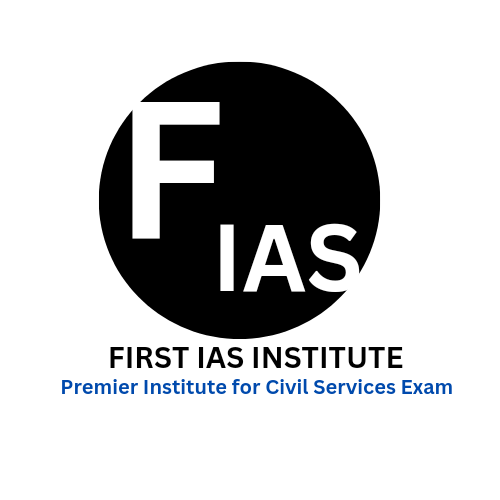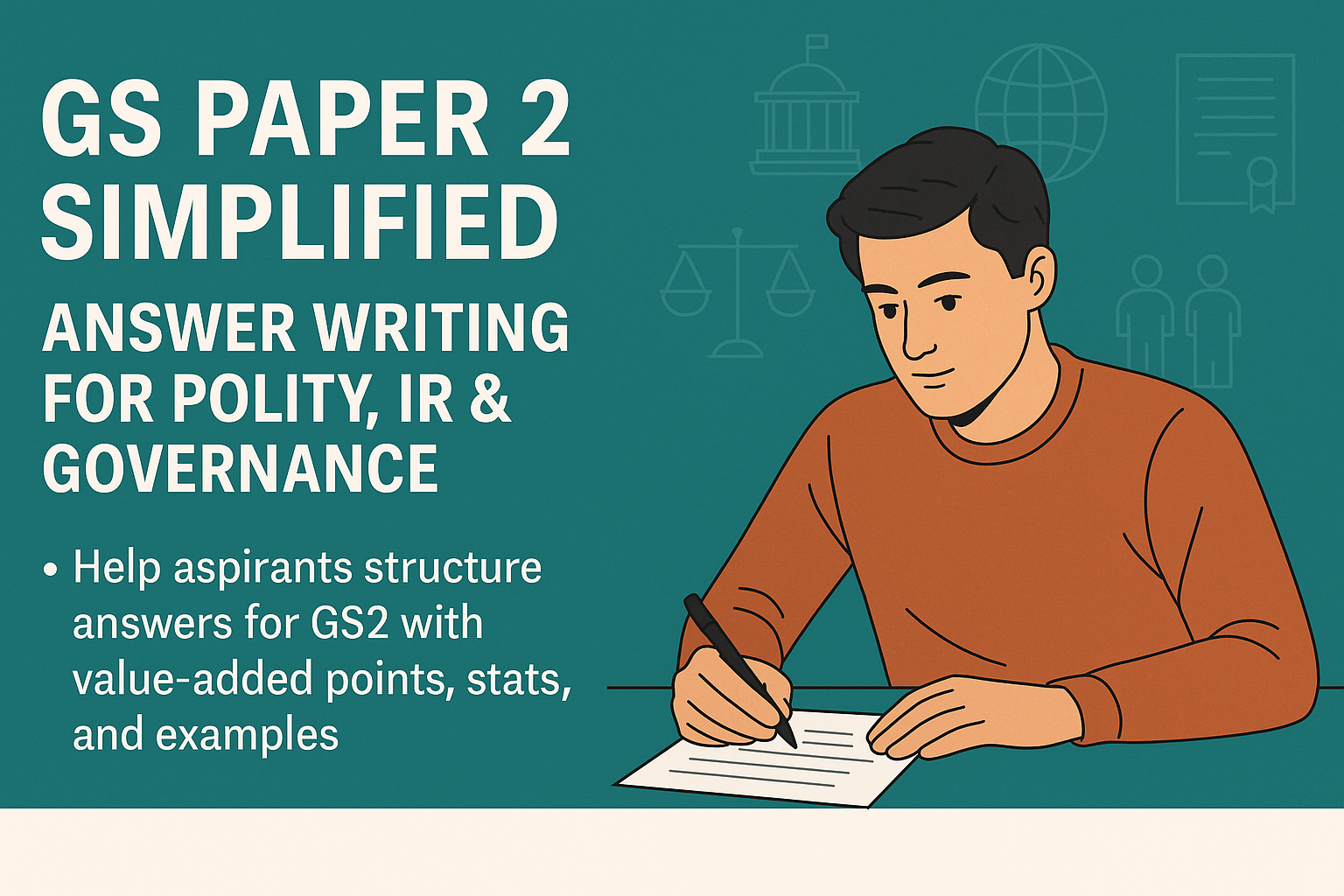GS Paper 2 Simplified: Answer Writing for Polity, IR & Governance
The General Studies Paper 2 (GS2) of the UPSC Civil Services Mains Examination demands a deep understanding of polity, governance, and international relations (IR). What makes it challenging is not just the vast syllabus but also the expectation of analytical, balanced, and structured answers within a limited timeframe. In this blog, we simplify GS2 answer writing by providing a clear structure, key stats, real examples, and effective value additions.
Understanding the Demand of GS Paper 2
GS2 covers three core areas:
- Indian Polity and Constitution
- Governance and Social Justice
- International Relations
Each question in GS2 is meant to test a candidate’s conceptual clarity, articulation, application of constitutional principles, and awareness of current affairs.
Join WhatsApp community for Free Notifications, Updates, Study Material, Mock Tests, Internship Updates, and Current Affairs - CLICK HERE TO JOIN
Key Directives in GS2 Questions
Before diving into writing, it is vital to understand the directive used in the question. Here’s what they imply:
- Discuss: Give a balanced view with arguments for and against.
- Examine: Probe deeper, evaluate causes, effects, and implications.
- Critically examine: Present both positives and negatives with a final judgment.
- Elaborate: Expand upon the given point with detailed explanation.
- Analyze: Break the topic into parts and explain the interrelationship.
Ideal Structure for GS2 Answer Writing
Introduction
- Define the key terms from the question.
- Set the context using a constitutional article, current event, or committee recommendation.
Body
- Break into subheadings based on the question.
- Use points or short paragraphs with examples, judgments, stats, and schemes.
Conclusion
- Summarize your argument.
- Suggest a way forward or quote a constitutional vision (e.g., “constitutional morality”, “Sabka Saath, Sabka Vikas”).
To Enroll in FIRST IAS INSTITUTE - Click Here
Mastering Answer Writing for Indian Polity
GS2 Polity questions often relate to constitutional bodies, federalism, judiciary, Parliament, and fundamental rights.
How to Introduce Polity Answers
- Begin with a constitutional article or landmark judgment.
- Define the key concept (e.g., “Judicial Review”, “Separation of Powers”).
Example: Question: "Judicial activism vs judicial overreach – analyze with suitable examples."
Intro: Judicial activism refers to proactive judicial decisions to uphold rights and justice, while judicial overreach is when the judiciary exceeds its mandate, encroaching on legislative or executive functions.
Body: Use Article-Based Framework
- Point 1: Mention relevant constitutional provisions (e.g., Article 13 for judicial review).
- Point 2: Use case laws like Kesavananda Bharati or S.R. Bommai.
- Point 3: Add real-world examples such as banning firecrackers, environmental rulings, etc.
Conclusion
Wrap with a quote: "Judiciary must act as the guardian of the Constitution but also respect the principle of separation of powers."
Writing Governance-Based Answers
Governance questions require practical insights into how institutions function, their gaps, and the way forward.
Key Themes in Governance
- Transparency and Accountability (RTI Act, Lokpal)
- E-Governance (Digital India, JAM trinity)
- Citizen-Centric Services
- Civil Services Reform
- Role of NGOs and SHGs
Framework to Structure Governance Answers
- Start with a definition or issue.
- Use government initiatives and recommendations (2nd ARC, NITI Aayog).
- Quote data from NITI Aayog, PRS Legislative Research, or ministries.
Example: Question: "Discuss the challenges of implementing e-governance in India."
Intro: E-governance refers to digital interactions between government and citizens/businesses. While Digital India has made progress, structural issues persist.
Body Points:
- Digital Divide: Only 43% rural households have internet (NFHS-5).
- Lack of capacity in lower bureaucracy.
- Cybersecurity concerns.
- Fragmented IT infrastructure.
Way Forward:
- Capacity building programs.
- Strengthening data privacy laws.
- Promoting digital literacy.
Conclusion: E-governance is not just about technology, but about governance transformation — accessible, accountable, and inclusive.
Join WhatsApp community for Free Notifications, Updates, Study Material, Mock Tests, Internship Updates, and Current Affairs - CLICK HERE TO JOIN
Writing for Social Justice Themes
Questions under social justice include:
- Welfare policies for vulnerable sections
- Health, education, nutrition
- Inclusive governance
Strategy to Tackle Social Justice Questions
- Use statistical data from NFHS, NCRB, ASER, NITI Aayog reports.
- Quote constitutional provisions (e.g., Article 39, 41, 46 under DPSPs).
- Mention flagship schemes (Poshan Abhiyaan, PMAY, Ayushman Bharat).
Example: Question: "Despite multiple efforts, malnutrition continues to plague India. Analyze."
Intro: As per NFHS-5, 35.5% of children under five are stunted. This reflects deep-rooted systemic issues.
Body:
- Inefficiencies in ICDS and mid-day meal schemes.
- Poor maternal health and sanitation.
- Social factors like early marriage and poverty.
Examples:
- Tamil Nadu’s community kitchens improving nutrition.
- Odisha’s “Mo Chhatua” scheme for ICDS strengthening.
Conclusion: A multi-sectoral and decentralized approach involving nutrition, education, sanitation, and health is needed.
Writing Effective International Relations Answers
IR questions test India’s foreign policy approach, diplomacy, and role in global institutions.
Introduction Tips for IR
- Begin with a recent development (e.g., G20 presidency, SCO meet).
- Or, quote a famous diplomat or India's foreign policy doctrine.
Example: Question: "Evaluate the strategic significance of QUAD for India."
Intro: The QUAD grouping represents India’s Indo-Pacific vision of ensuring a free, open, and inclusive region.
To Enroll in FIRST IAS INSTITUTE - Click Here
IR Answer Body Structure
- Geostrategic Significance: Maritime security, balancing China.
- Economic Cooperation: Trade, technology, supply chains.
- Challenges: No military component, lack of formal treaty.
- India’s Position: Strategic autonomy, Act East policy alignment.
Add Stats:
- India conducts Malabar naval exercises with QUAD partners.
- Indo-Pacific accounts for 60% of global GDP.
Conclusion: QUAD serves India’s interests in regional stability, economic resilience, and strategic cooperation without compromising autonomy.
Common Value Additions for GS2 Answers
To make your answers stand out, use the following:
Constitutional Provisions to Mention Often
- Article 14: Equality before law
- Article 19: Freedom of speech
- Article 21: Right to life
- Article 32/226: Right to constitutional remedies
- Article 243 to 243O: Panchayati Raj
- DPSPs (Part IV): Directive Principles
Committees and Commissions
- Punchhi Commission: Centre-State relations
- Second ARC: Governance reforms
- Justice Verma Committee: Women safety
- NITI Aayog Reports: Governance insights
Schemes and Initiatives
- Beti Bachao Beti Padhao
- Ayushman Bharat
- Mission Karmayogi
- Ujjwala Yojana
- Aspirational Districts Programme
Important Judgments
- Kesavananda Bharati Case: Basic structure doctrine
- SR Bommai Case: Federalism
- Navtej Singh Johar Case: LGBTQ+ rights
- Vishaka vs State of Rajasthan: Sexual harassment at workplace
- Minerva Mills Case: Judicial review
Quotes for Enrichment
- “Constitution is a living document, an instrument which makes the government system work” – B.R. Ambedkar
- “Good governance depends on ability to deliver – not just promises but performance” – Former PM
- “India’s foreign policy is based on enlightened self-interest” – Former NSA
Join WhatsApp community for Free Notifications, Updates, Study Material, Mock Tests, Internship Updates, and Current Affairs - CLICK HERE TO JOIN
Answer Writing Tips from Toppers and Experts
Time Management
- Practice writing 20 questions in 3 hours regularly.
- Allocate 6-7 minutes per 10-marker and 11 minutes per 15-marker.
Use Diagrams and Flowcharts
- For administrative structure, interlinkages between ministries, IR groupings.
- Keep them clean and labeled properly.
Don't Just Describe, Analyze
- Every point should be followed by why and so what.
- Link current events to the static part of the syllabus.
Practice Previous Year Questions
- Questions repeat in theme if not in words.
- Practice GS2 PYQs from the past 5 years in a time-bound manner.
Role of Mock Tests and Feedback
Consistent practice of mock tests under exam-like conditions is essential. Detailed feedback on structure, relevance, and presentation helps bridge gaps. At First IAS Institute, aspirants are trained to internalize answer formats, identify directive-based expectations, and develop conceptual clarity under experienced mentorship.
To Enroll in FIRST IAS INSTITUTE - Click Here
Final Thoughts: GS2 is About Governance in Action
GS Paper 2 is not a test of how much you know, but how effectively you apply what you know. It's about connecting constitutional ideals to current realities, evaluating policy implementation, and understanding India’s role in a dynamic world.
Write like a public servant — balanced, informed, and solution-oriented.
By following a structured approach, integrating data, quoting the Constitution, and thinking analytically, your GS2 answers can move from average to excellent.


 firstiasofficial@gmail.com
firstiasofficial@gmail.com
Leave a Comment